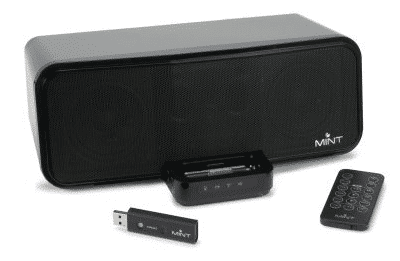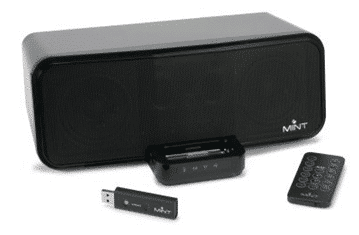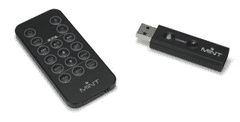There are so many different speaker for iPods and other personal audio players out there that I’m almost reluctant to review any anymore. There is rarely any point of differentiation making it worth even discussing. But every once and a while, I come across a speaker system that is a bit different, enough so to write about. The Mint Studio is an example of this type of product.
Docking an iPod or iPhone into a small speaker set is nothing new. There are literally hundreds of those out there and some are better than others. However, you need to look though all of the feature to find out the perfect mix for you. Some are stand-alone systems (dock and speaker), others have more functionality (Radio, iPod dock, auxiliary in, etc.), some have amazing fidelity and bass and others have docks that hook right into your stereo. And there are some audio systems that do not involve any types of speakers but simply stream audio from your laptop to a stereo. As you can see, I have reviewed many of those types.
So why the Mint Studio? For starters, it does have the requisite iPod doc, and even has a remote as well to control it. However, it goes beyond that with the help of a very simple USB dongle. The dongle just plugs into either a Mac or PC, and once you have select the Mint Studio as the audio output device, any and all audio streams from your computer to the speaker. And, multiple speakers can be included into the mix so that you can stream your computer’s audio to various rooms around a house, for example.
An Evolution of Technology
From my understanding, the Mint team has worked on trying to perfect the best audio streaming solution around, and at a reasonable price to boot. But this has been a process of improvements over time. They outlined the following timeline with me of the evolution of their wireless solution:
- 1st Generation – the Mint 300 & Mint 220 used Open Solution Company’s wireless module. However they found that WiFi connection were interrupted in about 10% of customers.
- 2nd Generation – the Mint 130 was introduced which was a change from the Open Solution wireless stack to Avnera. The Avnera 1G solution did not have PA (Power Amplification) on the RF signal and it was still causing interference, but not quite the same as the one that happened when using the Open Solution stack. There was sound dropping when using the 1G solution as it searched for unused 2MHz band. By not using the Power Amplification, there was a limit to the wireless range of about 40ft so it was deemed an “in-room system.”
- 3rd Generation – this is the current generation, the one that is the Mint Studio. Once again, the innards were change to create a better wireless solution. Details below.
Geeking out with the Mint Studio
So this latest generation made some significant strives forward. For starters, they upgraded to a 1.5G Avnera which has Power Amplification built in to the transmitter. To ensure better wireless connectivity, the Mint team built in two antennas inside the speaker to extend the wireless operating range. I’m told that if you have line-of-sight between the USB dongle and the speaker, you can actually reach 100 yards! Optimally within a house with plenty of walls and other interference, the range is probably about 100 feet.
The Mint Studio allows for up to 3 distinct 1.5G speakers which means that you can stream music (or audio) from your computer to up to 3 rooms in your house.
The system uses two 2MHz channels in order to minimize the amount of interference that may be caused by other wireless devices (like routers) in your house. Basically, the USB transmitter can switch channels dynamically without cutting off sound if the used channel is requested by a WiFi router.
Putting the Mint Studio to Use
I ran some rudimentary tests with the Mint Studio. The setup was quite easy. First just docking an iPod and changing the source (buttons on the side of the dock) produced immediate effects…with music coming out of the dual speaker assembly. The speakers are 3″ advanced alloy (magnesium/aluminum) cone range transducers.
Next, I tried connecting the USB transmitter to my Mac. As with other USB devices, I simply had to go into the System Preferences and select “Mint Wireless USB Audio” and power on the Mint speaker. Once the two items are paired, I was streaming audio from my computer. It took literally seconds. The same process is done within a Windows PC (with the usual configuration of the USB devices) and then you select the Mint as the audio output device.
The connectivity and streaming process was pretty easy and good. The sound output, however, was the only weak link in the entire setup. Yes, streaming works great. The music that comes out is crisp and clean, but a little bit too crisp for my taste. I found the treble to be good and clear, with very distinct highs. However, while the treble was great, I found that the bass was pretty weak. I actually had to turn on my equalizer in iTunes and select the “Bass Booster” setting to make the sound meet my needs. The speaker setup is small, which probably means that there were some sacrifices in the bass.
For a fourth generation product, I would really hope that Mint put in a down-firing bass. This will probably mean that the size of the speaker will be a bit larger (and so will the price). Currently, the retail price is $149, which in my opinion is a fantastic deal for the features that you get. For about $175 and added bass, it would be a solid product worthy of competing with others in the market, if not beating them out. As it stands right now, the Mint Studio can go head to head with many different similar products on the market. They have come a long way with the wireless solution side and I’m betting that their next product will be even better.
You can currently pick up the Mint Studio on Amazon for $140 which makes it a really good deal.
Disclosure Text : I have a material connection because I received a gift or sample of a product for consideration in preparing to write this content. I was/am not expected to return this item or gift after my review period. More information can be found in my About page as well as here.
HTD says: the Mint Studio gives you a great way to connect not only iPods to a speaker solution, but Mint’s innovative and advanced wireless audio streaming solution for Mac/PCs makes it a nice, well-rounded speaker system.
[amazonproduct=B001RNNXQM]




